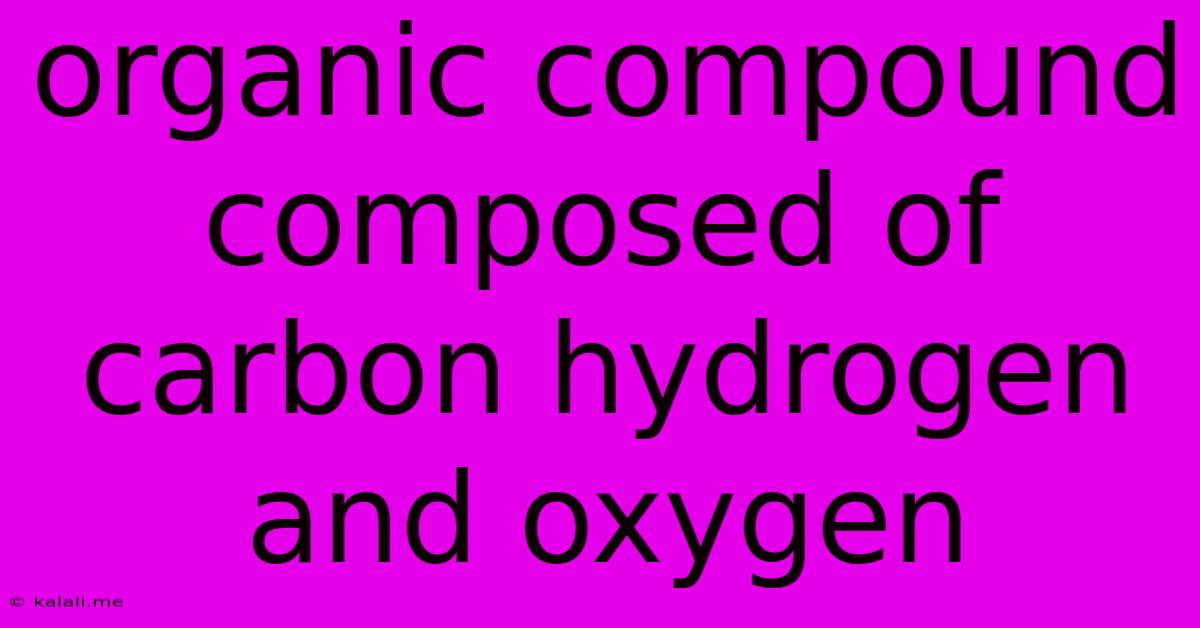Organic Compound Composed Of Carbon Hydrogen And Oxygen
Kalali
May 10, 2025 · 3 min read

Table of Contents
Organic Compounds Composed of Carbon, Hydrogen, and Oxygen: Exploring the World of Carbohydrates and More
Organic compounds containing only carbon (C), hydrogen (H), and oxygen (O) form a crucial class of molecules fundamental to life. While seemingly simple in their elemental composition, these compounds exhibit incredible diversity in structure and function, playing vital roles in various biological processes. This article delves into the characteristics, classifications, and importance of these essential organic compounds, focusing primarily on carbohydrates but also touching upon other significant examples.
Understanding the Building Blocks: The unique bonding properties of carbon allow it to form long chains and complex ring structures with hydrogen and oxygen atoms attached. This versatility is the foundation for the vast array of molecules found in this class. The ratio of these elements can vary significantly, leading to a wide range of chemical properties and biological functions.
Carbohydrates: The Cornerstone of Life
Carbohydrates, also known as saccharides, are perhaps the most well-known group of organic compounds composed solely of carbon, hydrogen, and oxygen. Their general formula is often represented as (CH₂O)ₙ, where 'n' represents the number of carbon atoms. This simple formula, however, masks the complexity of their structures and functions.
Types of Carbohydrates: Carbohydrates are categorized into three main groups based on their structure and size:
-
Monosaccharides: These are the simplest carbohydrates, also known as simple sugars. Glucose, fructose, and galactose are common examples, all with the chemical formula C₆H₁₂O₆. They are the building blocks for more complex carbohydrates. Their roles include providing immediate energy for cellular processes.
-
Disaccharides: These are formed by the joining of two monosaccharides through a glycosidic bond, a process involving the removal of a water molecule (dehydration synthesis). Sucrose (table sugar), lactose (milk sugar), and maltose (malt sugar) are examples of disaccharides. They are often used as energy sources, particularly in plants and animals.
-
Polysaccharides: These are complex carbohydrates formed by the linkage of many monosaccharides. Starch (in plants), glycogen (in animals), and cellulose (in plant cell walls) are prime examples. They serve as long-term energy storage or structural components. The differing linkages between monosaccharides in these polymers give rise to their distinct properties and functionalities.
Beyond Carbohydrates: Other C, H, O Compounds
While carbohydrates dominate this category of organic compounds, other important molecules also fall under this classification, although they may have additional functional groups or more complex structures. Examples include:
-
Organic Acids: Many organic acids, such as acetic acid (CH₃COOH) and lactic acid (CH₃CH(OH)COOH), contain only carbon, hydrogen, and oxygen. These play vital roles in metabolic pathways and are found in various biological systems.
-
Some Lipids: Certain lipids, like some fatty acids, also fit this description although they typically also contain other elements. These are essential components of cell membranes and energy storage molecules.
The Importance of C, H, O Compounds
The importance of organic compounds composed of carbon, hydrogen, and oxygen cannot be overstated. They are fundamental to life, playing roles in:
-
Energy production: Carbohydrates are the primary source of energy for most living organisms.
-
Structural support: Cellulose provides structural support in plant cell walls, while chitin forms the exoskeletons of insects and crustaceans.
-
Metabolic regulation: Various organic acids act as intermediaries and regulators in numerous metabolic pathways.
-
Information storage: While not the primary focus, certain molecules like ribose (a monosaccharide) are crucial components in RNA and DNA.
In conclusion, the seemingly simple combination of carbon, hydrogen, and oxygen gives rise to a vast array of organic compounds with diverse structures and functions. Understanding their characteristics and roles is crucial to grasping the complexities of biological systems and the processes that sustain life itself. Further research into the intricacies of these compounds promises to unlock further insights into the biological world.
Latest Posts
Latest Posts
-
What Is A Third Of A Pound
May 10, 2025
-
How Many Oz In 40 Ml
May 10, 2025
-
16 Out Of 25 As A Grade
May 10, 2025
-
What Is 7 4 7 As An Improper Fraction
May 10, 2025
-
How Much Is 1 Cup Sour Cream
May 10, 2025
Related Post
Thank you for visiting our website which covers about Organic Compound Composed Of Carbon Hydrogen And Oxygen . We hope the information provided has been useful to you. Feel free to contact us if you have any questions or need further assistance. See you next time and don't miss to bookmark.